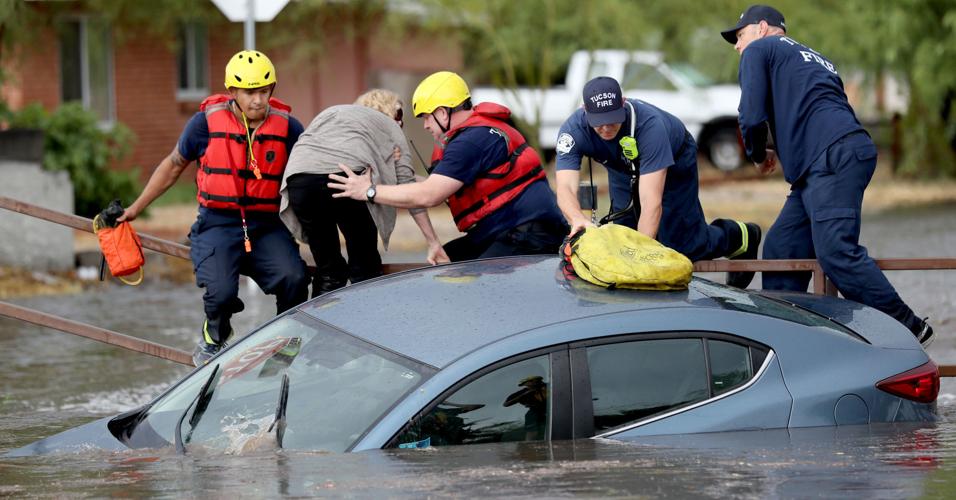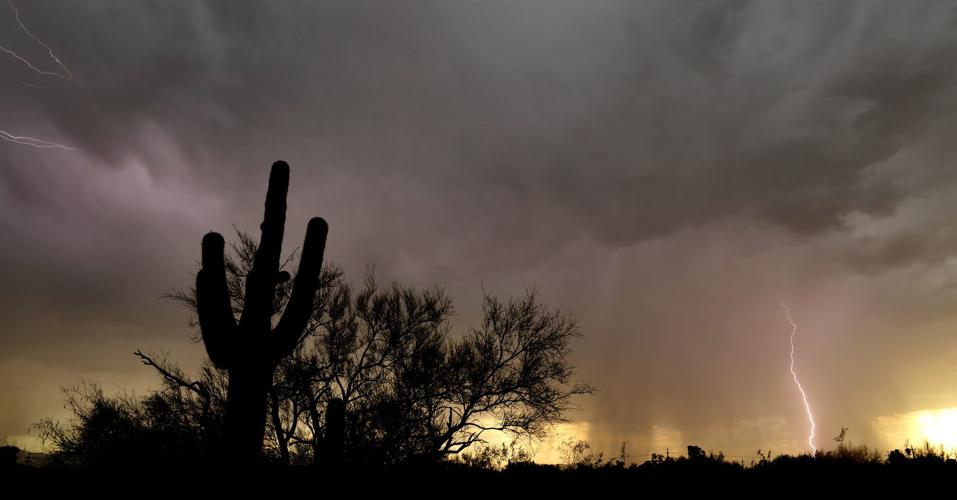Tucson experienced below average rainfall in July — typically an active month for the monsoon — but there is still hope for August and September, according to local weather experts.
Consistent with predictions the monsoon would come late this year, July officially brought about an inch of rain — a good portion of that falling Wednesday afternoon — which is low compared to the normal 2.25 inches recorded during the month.
Tucson’s monsoon runs from mid-June to the end of September; an average season is about 6 inches of rain.
“It really comes down to the fact that the high-pressure system that draws up most of our moisture to get these storms initiated hasn’t really had an easy time sticking to its most favorable position,” said National Weather Service meteorologist Maddie Powell. “It’s been shifting a lot and any little variation in where that high sits can mean the difference between a busy day and a non-busy day as far as rain goes.”
According to Powell, the Southwest typically sees a seasonal shift from a low-pressure system in the winter to a high-pressure system in the summer. The high-pressure system travels north toward the Four Corners region from Mexico, which causes the wind to shift and brings in moisture from the Gulf of California. This year, the high-pressure system is more active in its movement.
“It just comes down to where that high is, and part of that is just the lingering effects we had through the spring from El Niño, which didn’t really allow that high pressure to set up,” Powell said.
Earlier in the year, low-pressure systems stuck around longer and combined with El Niño weather conditions to create lower than normal temperatures and increased moisture through May. Because high-pressure systems depend on heat to push them north, Arizona’s cool spring is causing a delay in monsoon storms.
Although rainfall for the center of Tucson, which is recorded at the airport, is below normal, other areas of Tucson are experiencing plenty of rain.
“Rain events have been fewer and far between, but the variability is typical for this time of year,” said University of Arizona climatologist Mike Crimmins. “A lot of the storms have stuck to the mountains, but the middle of Tucson has been struggling.”
Heading into August, there’s still a chance that monsoon storms will increase, according to Crimmins.
The Tucson area has seen increased storm activity this week, including heavy downpours Wednesday that caused some washes to flow. Some areas of Tucson reported more than 2 inches of rain by Wednesday evening, particularly on the southeast side.
“I still think there’s plenty of time to catch up,” Crimmins said. “On average, August is the wettest month of the monsoon season, so there’s still opportunity for other parts of town to experience those storms.”
The weather service said whether the rains pick up through August primarily depends on the high-pressure systems’ placement.
“It’s difficult to say that August is going to be a slam dunk or it’s not,” Powell said. “It’s kind of sitting in the equal-chances range, not above or below average as far as expected precipitation goes.”
According to Crimmins, there’s also a chance that Southern Arizona will experience higher rainfall in September as well, which could make up for its nearly dry July.
“The first two weeks of September are usually when the monsoons tail off, but this year there is the expectation that we’ll experience some tropical storm activity,” he said. “Since it’s been an active season, it’s definitely something we might contend with in September.”
Photos: Tucson's 2019 monsoon
Monsoon 2019
Updated
A lightning bolt strikes in the western part of the city, part of the second of two bands of monsoon storms to roll over the area, Tucson, Ariz., August 28, 2019.
Monsoon 2019
Updated
The sunset is reflected in the rain slicked intersection of Ajo Way and Valencia Rd., during the first of two bands of monsoon storms to roll over the area, Tucson, Ariz., August 28, 2019.
Monsoon 2019
Updated
Sunset over the construction project at the former La Placita Village, near Church and Broadway downtown Tucson, Ariz., August 16, 2019.
Monsoon 2019
Updated
A disabled car sits in the flooded wash at Copper and Wilson as the waters in the wash rise around it as monsoon finally delvers some rain, Tucson, Ariz., August 10, 2019.
Monsoon 2019
Updated
A bicyclist negotiates the overflow from a wash crossing Glenn at Wilson as the monsoon finally delvers some rain, Tucson, Ariz., August 10, 2019.
Monsoon 2019
Updated
Rural Metro Fire Department personnel watch over the flooded Julian Wash at Irvington after being dispatched for a swift water rescue as monsoon finally delvers some rain, Tucson, Ariz., August 10, 2019. Rescue ended up being not needed as the subject safely walked out of the wash on their own just as the RMFD arrived.
Monsoon 2019
Updated
In a monsoon haze, the sun sets behind a ridge just west of Greasewood near Starr Pass, Tucson, Ariz., August 8, 2019.
Monsoon 2019
Updated
Bank of America Plaza and One South Church, the former UniSource Energy Tower, catch the last of the day's colorful sunlight filtered through monsoon clouds, Tucson, Ariz., August 8, 2019.
Monsoon 2019
Updated
Sunset lights the clouds over the dozens of international flags flying behind The National Law Center for Inter-American Free Trade, 440 N Bonita Ave., Tucson, Ariz., August 8, 2019.
Monsoon 2019
Updated
Monsoon clouds make a big show over the valley, but fail to deliver on the promises of rain, Tucson, Ariz., August 7, 2019.
Monsoon over Sunnyside football
Updated
Sunnyside players get warmed up as a monsoon storm rolls in overhead during the Blue Devils' practice, Tucson, Ariz., August 6, 2019.
Monsoon
Updated
Monsoon storm clouds roll over the new control tower at Tucson International Airport, Tucson, Ariz., August 3, 2019.
Monsoon 2019
Updated
A patchy monsoon storm drops some heavy, but isolated rain, on the southeast side just after sunset, Tucson, Ariz., August 1, 2019.
Monsoon 2019
Updated
A patchy monsoon storm drops two lightning bolts on the southeast side, Tucson, Ariz., August 1, 2019.
Monsoon 2019
Updated
A patchy monsoon storm throws down a lightning bolt on the southeast side, Tucson, Ariz., August 1, 2019.
Monsoon 2019
Updated
A patchy monsoon storm throws down a snaky lightning bolt on the southeast side, Tucson, Ariz., August 1, 2019.
Monsoon 2019
Updated
A patchy monsoon storm throws down a lightning bolt on the southeast side, Tucson, Ariz., August 1, 2019.
Monsoon 2019
Updated
A biker pedal through the water running down Desert Ave. and flowing across Glenn in the aftermath of monsoon downpour, Tucson, Ariz., July 31, 2019.
Monsoon 2019
Updated
Tucson Fire Department personnel extricate a woman from a car pinned against the sidewalk safety railings at culvert overflowing Glenn Street at Wilson Street in Tucson, Ariz., July 31, 2019.
Monsoon 2019
Updated
A monsoon front rolls in over the city bringing brief, but heavy rain in Tucson, Ariz., July 31, 2019.
Monsoon
Updated
Monsoon sunset behind a ridge northwest of Kinney Rd., Tucson, Ariz., July 25, 2019.
Monsoon 2019
Updated
A biker heads east along Cushing St. near the Santa Cruz River under a monsoon sunset, Tucson, Ariz., July 24, 2019.
Monsoon 2019, bats take flight
Updated
A member of the crowd gets cell phone video of the nightly exodus of thousands of Mexican free-tailed bats from under the Campbell Ave. bridge over the Rillito River, Friday, July 19, 2019, Tucson, Ariz. Friday was Bats in Flight night at the bridge, and Pima County naturalists were on hand to answer questions and guide a few all-ages bat related activities. The next scheduled Bats in Flight is August 17, 6:30 - 8:30 p.m., it's free and no registration is needed.
Monsoon
Updated
A falcon rides the lines running along Speedway just east of Greasewood under a monsoon sunset, Wednesday, July 17, 2019, Tucson, Ariz.
Monsoon 2019
Updated
Lighting strikes straddle a ridge in the Rincon Mountains east of Tucson, looking east from the Agua Caliente Wash at Houghton Road on Sunday, July 14, 2019, Tucson, Ariz.
Monsoon 2019
Updated
A worker from Pearson's Signs helps to lower the PPEP Inc. sign down to the ground after high winds from Saturday's monsoon storm tipped the sign over at 901 E. Benson Highway on July 15, 2019. PPEP Inc., Portable, Practical Educational Preparation, is a non-profit that provides services to empower people living in rural areas through education, health, housing, counseling, employment, job training and many others.
Monsoon 2019
Updated
A monsoon storm, the first significant one of the season, crashes a few bolts down just before the gates opened for the Annual Bloom Night at Tohono Chul Park, July 13, 2019, Tucson, Ariz.
Monsoon 2019
Updated
Monsoon sunset behind downtown, Saturday, July 6, 2019, Tucson, Ariz.
Monsoon
Updated
The last bit of a monsoon storm breaks up in the sky just west of town after dropping a few sprinkles before fading away, Friday, July 5, 2019, Marana, Ariz.
Monsoon
Updated
A bolt of lightning appears to hit the high-rise at 5151 E. Broadway as a monsoon cell moves over the eastern part of town, Saturday, July 6, 2019, Tucson, Ariz.
Monsoon
Updated
Monsoon sunset behind downtown, Saturday, July 6, 2019, Tucson, Ariz.
Monsoon
Updated
Monsoon sunset throws light on the Union Pacific Railroad tracks running under Kino Parkway at Aviation Highway, Saturday, July 6, 2019, Tucson, Ariz.





